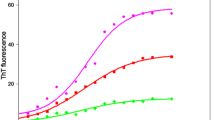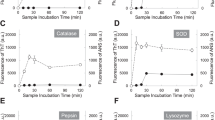Abstract
Alzheimer’s disease is associated with the fibril formation of β-amyloid peptide in extracellular plaque. β-Casein is a milk protein that has shown a remarkable ability to stabilize proteins by inhibiting their protein aggregation and precipitation. The aim of this study was to test in vitro the ability of β-casein to bind the Aβ1–40, change the structure and inhibit the formation of amyloid fibrils in Aβ1–40. Results from the ThT binding assay indicated that incubation of Aβ1–40 with β-casein retarded amyloid fibril formation of Aβ1–40 in a concentration dependent manner such that at a ratio of 1:1 (w:w) led to a significant reduction in the amount of fluorescent intensity. The results from transmission electron microscopy (TEM) also showed that β-casein significantly reduced the number and size of the Aβ1–40 fibrils, suggesting that the chaperone bound to the Aβ1–40 fibrils and/or interacted with the fibrils in some way. ANS results also showed that β-casein significantly decreased the exposed hydrophobic surface in Aβ1–40. Following an ANS binding assay, CD spectroscopy results also showed that incubation of Aβ1–40 resulted in a structural transition to a β-sheet. In the presence of β-casein, however, α-helical conformation was observed which indicated stabilization of the protein. These results reveal the highly efficacious chaperone action of β-casein against amyloid fibril formation of Aβ1–40. These results suggest that in vitro, β-casein binds to the Aβ1–40 fibrils, alters the Aβ1–40 structure and prevents amyloid fibril formation. This approach may result in the identification of a chaperone mechanism for the treatment of neurological diseases.





Similar content being viewed by others
References
Bellesia G, Shea JE (2009) Effect of beta sheet propensity on peptide aggregation. J Chem Phys 130:145103
Berchtold NC, Cotman CW (1998) Evolution in the conceptualization of dementia and Alzheimer’s disease: Greco-Roman period to the 1960s. Neurobiol Aging 19(3):173–189
Bhattacharyya J, Santhoshkumar P, Sharma KK (2003) A peptide sequence—YSGVCHTDLHAWHGDWPLPVK[40–60]—in yeast alcohol dehydrogenase prevents the aggregation of denatured substrate proteins. Biochem Biophys Res Commun 307:1–7
Bourhim M, Kruzel M, Srikrishnan T, Nicotera T (2007) Linear quantitation of Aβ aggregation using Thioflavin T: reduction in fibril formation by colostrinin. J Neurosci Methods 160:264–268
Cardamone M, Puri NK (1993) Spectrofluorimetric assessment of the surface hydrophobicity of proteins. Biochem J 282:589–593
Carrotta R, Canale C, Diaspro A, Trapani A, San Biagio PL, Bulone D (2012) Inhibiting effect of αs1-casein on Aβ1–40 fibrillogenesis. Biochim Biophys Acta 1820:124–132
Cassiano MM, AreÃas JAG (2001) Study of bovine β-casein at water/lipid interface by molecular modeling. J Molec Struct 539:279–288
Chaney MO, Webster S, Kuo Y, Roher A (1998) Molecular modelling of the AL 42 peptide from Alzheimer’s disease. Protein Eng 11:761–767
Danielsson J, Jarvet J, Damberg P, Graslund A (2002) Translational diffusion measured by PFG-NMRon full length and fragments of the Alzheimer Ab(1-40) peptide. Determination of hydrodynamic radii of random coil peptides of varying length. Magn Reson Chem 40:S89–S97
Dobson CM (1999) Protein misfolding, evolution and disease. Trends Biochem Sci 24:329–332
Dobson CM (2001) The structure basis of protein folding and its links with human disease. Phil Trans R Soc Lond B 356:133–145
Ehrnsperger M, Graber S, Gaestel M, Buchner J (1997) Binding of non-native protein to Hsp25 during heat shock creates a reservoir of folding intermediates for reactivation. EMBO J 16:221–229
Farrell HM Jr, Jimenez-Flores R, Bleck GT, Brown EM, Butler JE, Creamer LK et al (2004) Nomenclature of the proteins of cows’ milk—sixth revision. J Dairy Sci 87(6):1641–1674
Forloni G, Tagliavini F, Bugiani F, Salmona M (1996) Amyloid in Alzheimer’s disease and prion-related encephalopathies: studies with synthetic peptides. Prog Neurobiol 49:287–315
Gasymov OK, Glasgow BJ (2007) ANS fluorescence: potential to augment the identification of the external binding sites of proteins. Biochim Biophys Acta 1774:403–411
Goldgaber D, Schwarzman A, Bhasin R, Gregori L, Schemechel D, Saunders A et al (1992) Sequestration of Amyloid β-Peptide. Ann N Y Acad Sci 695:139–143
Guha S, Manna TK, Das KP, Bhattacharyya B (1998) Chaperone-like activity of tubulin. J Biol Chem 273:30077–30080
Harper JD, Wong SS, Lieber CM, Lansbury PT Jr (1997) Observation of metastable Aβ amyloid protofibrils by atomic force microscopy. Chem Biol 4:119–125
Hartl FU (1996) Molecular chaperones in cellular protein folding. Nature 381:571–580
Hartmann T, Bieger SC, Brühl B, Tienari PJ, Ida N, Allsop D et al (1997) Distinct sites of intracellular production for Alzheimer’s disease A beta40/42 amyloid peptides. Nat Med 3(9):1016–1020
Husband FA, Wilde PJ, Mackie AR, Garrood MJ (1997) A comparison of the functional and interfacial properties of β-casein and dephosphorylated β-casein. Colloid Interface Sci 195:77–85
Jarrett JT, Berger EP, LansburyP T Jr (1993) The C-terminus of the beta protein is critical in amyloidogenesis. Ann NY Acad Sci 695(14):4–148
Kayed R, Head E (2003) Common structure of soluble amyloid oligomers implies common mechanism of pathogenesi. Science 300(5618):486–489
Kelly JW (2000) Mechanisms of amyloidogenesis. Nat Struct Biol 2000(7):824–826
Lee GJ, Roseman AM, Saibil HR, Vierling E (1997) A small heat shock protein stably binds heat-denatured model substrates and can maintain a substrate in a folding-competent state. EMBO J 16(3):659–671
Lomakin A, Chung DS, Benedek GB, Kirschner DA (1996) Teplow DB (1996) On the nucleation and growth of amyloid β-protein fibrils: detection of nuclei and quantitation of rate constants. Proc Nat Acad Sci 93:1125–1129
Manna T, Sarkar T, Poddar A, Roychowdhury M, Das KP, Bhattacharyya B (2001) Chaperone-like activity of tubulin. binding and reactivation of unfolded substrate enzymes. J Biol Chem 276(43):39742–39747
Matulis D, Baumann CG, Bloomfield VA, Lovrien RE (1998) 1-Anilino-8-Naphtalene Sulfonate as a protein conformational tightening agent. Biopolymers 49:451–458
Muchowski PJ (2002) Protein misfolding, amyloid formation and neurodegeneration: a critical role for molecular chaperones? Neuron 35:9–12
Naiki H, Gejyo F (1999) Kinetic analysis of amyloid fibril formation. Methods Enzymol 309:305–318
Nichols MR, Moss MA, Reed DK, Lin WL, Mukhopadhyay R, Hoh JH et al (2002) Growth of β-amyloid(1-40) protofibrils by monomer elongation and lateral association. Characterization of distinct products by light scattering and atomic force microscopy. Biochemistry 41:6115–6127
Rekas A, Adda CG, Andrew Aquilina J, Barnham KJ, Sunde M, Galatis D, Williamson NA et al (2004) Interaction of the molecular chaperone aB-crystallin with a-synuclein: effects on amyloid fibril formation and chaperone activity. J Mol Biol 340:1167–1183
Schein CH (1990) Solubility as a function of protein structure and solvent components. Nat Biotechnol 8:308–317
Seilheimer B, Bohrmann B, Bondole L, Muller F, Stuber D, Dobeli H (1997) The toxicity of the Alzheimer’s L-amyoid peptide correlates with a distinct eber morphology. J Struct Biol 119:59–71
Serpell LC (2000) Alzheimer’s amyloid fibrils: structure and assembly. Biochim Biophys Acta 1502:16–30
Shin RW, Ogino K (1997) Amyloid b-protein Aβ1–40 but not Aβ1–42 contributes to the experimental formation of Alzheimer disease amyloid fibrils in rat brain. J Neurosci 1:8187–8193
Simmons LK, May PC, Tomaselli KJ, Rydel RE, Fuson KS, Brigham EF, Wright S et al (1994) Secondary structure of amyloid beta peptide correlates with neurotoxic activity in vitro. Mol Pharmacol 45(3):373–379
Stege GJJ, Renkawek K, Overkamp PSG, Verschuure P, van Rijk AF, Reijnen-Aalbers A et al (1999) The molecular chaperone αB-crystallin enhances amyloid β neurotoxicity. Biochem Biophys Res Commun 262:152–156
Sunde M, Serpell LC, Bartlam M, Fraser PE, Pepys MB, Blake CC (1997) Common core structure of amyloid fibrils by synchrotron X-ray diffraction. J Mol Biol 273(3):729–739
Takeda T, Klimov DK (2009) Interpeptide interactions induce helix to strand structural transition in Abeta peptides. Proteins 77(1):1–13
Tycko R (2000) Solid-state NMR as a probe of amyloid fibril structure. Curr Opin Chem Biol 4:500–506
van Montfort RL, Basha E, Friedrich KL, Slingsby C, Vierling E (2001) Crystal structure and assembly of a eukaryotic small heat shock protein. Nat Struct Biol 8:1025–1030
Wetzel R (2002) Ideas of order for amyloid fibril structure. Structure 8:1031–1036
Xu S (2007) Aggregation drives “misfolding” in amyloid fiber formation. Amyloid 14:1119–1131
Zhang X, Fu X, Zhang H, Liu C, Jiao W, Chang Z (2005) Chaperone-like activity of β-casein. Int J Biochem Cell Biol 37:1232–1240
Acknowledgments
This article does not contain any studies with human and animal subjects performed by any of the authors. All authors (Ghahghaei A, Shahraki S) declare that they have no conflict of interest. The authors are thankful to the university of Sistan and Baluchestan for providing the necessary facilities.
Author information
Authors and Affiliations
Corresponding author
Rights and permissions
About this article
Cite this article
Ghahghaei, A., Shahraki, S. Inhibitory Effect of β-Casein on the Amyloid Fibril Formation of Aβ1–40 Associated with Alzheimer’s Disease. Int J Pept Res Ther 22, 23–29 (2016). https://doi.org/10.1007/s10989-015-9482-8
Accepted:
Published:
Issue Date:
DOI: https://doi.org/10.1007/s10989-015-9482-8




